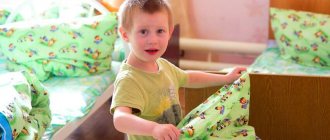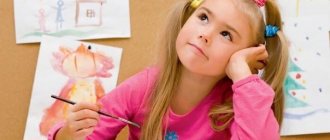Introducing works of art in kindergarten to middle preschool age
Introducing works of art in kindergarten
in middle preschool age
In the middle group, work to familiarize children with works of art continues, and I, following the recommendations of the authors of the comprehensive programs “Rainbow”, “Development”, “Education and Training in Kindergarten”, “Childhood”, solve the following tasks:
· Continue to examine objects of folk and decorative art.
· Introduce children to the profession of an artist.
· Develop the ability to identify genres and types of art: painting, sculpture, architecture.
· To consolidate children’s knowledge about books and book illustrations.
· Foster a caring attitude towards works of art.
In middle preschool age, children continue to become acquainted with works of fine art. Throughout the year, the children and I look at illustrations for children's books made by famous artists: Vasnetsov, Konashevich, Charushin, etc. Children get acquainted with small sculpture: bronze, porcelain, wooden images of animals and people with a pronounced character, plastic movement.
I choose material on fine arts, which is divided into sections: decorative arts, graphics, painting (still life, landscape, portrait, genre painting), sculpture, its types.
In September, October, November, I continue to introduce children to the depiction of floral patterns in the works of folk craftsmen and works of decorative and applied art, talk about the features of folk decorative and applied art, and organize an exhibition of works by folk craftsmen in the group.
In December, I talk about the profession of an artist.
In January, I continue to work on developing the perception of beautiful patterns and ornaments in works of folk and decorative art. I continue to introduce you to the profession of an artist.
In February, March and April I plan to look at the illustrations, talk about the work of illustrators, and organize an exhibition.
The authors of the comprehensive programs “Rainbow”, “Development”, “Education and Training in Kindergarten”, “Childhood” advise children to look at illustrations and reproductions of paintings - but do not indicate which artists specifically.
However, the Rostock program presents this material in particularly detail.
Thus, based on the recommendations of the authors of comprehensive programs, I collected and systematized material on introducing fine arts to the middle group.
In middle preschool age, I continue to introduce children to household objects, wooden toys (Bogorodsk carvings), objects made of carved birch (boxes, caskets), and creative objects (Vologda lace, knitting, embroidery).
When introducing the profession of an artist, I tell the children that artists are people who paint pictures, create illustrations for books, and make many surrounding objects beautiful. I show children various genres of painting - still life, portrait, landscape, fairy tale.
To introduce children to works of art, I most fully use the material from Shestakova’s “Rostock” partial program. Here work is carried out seasonally.
I continue to introduce children to sculpture, teach them to distinguish sculpture from painting, to learn the features of its content and some means of expression: volume, movement, the significance of the material from which the sculpture is made.
According to the author (“Program of education and training in kindergarten”), I introduce children to architecture, or rather, to the building of a school and kindergarten, a residential building with many floors, entrances, apartments, the building of circuses, theaters.
Acquaintance with works of art in our group is carried out on the basis of rich accumulated material.
Get text
A long-term plan for introducing preschoolers to various genres of painting
Long-term plan for familiarization
preschoolers with various genres of painting
(from first junior to preparatory group)
First junior group
| No. | Month | Genres of painting | Painting | Target | |
| 1 | 10. | Decorative and applied | Filimonovskaya toy | Introduce children to the Filimonov toy as a bright representative of the traditional folk art of our homeland | |
| 2 | 01. | Small sculptures | Duck with ducklings or others. | Developing interest in creativity, familiarization with the structure of birds | |
| 3 | 03. | Matryoshka - Russian souvenir | Semyonovskaya matryoshka | To cultivate a love for folk art, respect for the folk artist who creates beauty for the joy of people | |
| 4 | 04. | Animalistic | Suteev V.G. Illustrations for children's books | To develop knowledge about the animalistic genre in the fine arts, to evoke an emotional response to the beauty of the animal world. | |
Second junior group
| No. | Month | Genres of painting | Painting | Target |
| 1 | 09. | Fabulously epic | V.M. Vasnetsov “Alyonushka” | To form an idea of the fairy-tale genre in painting using the example of the work of V. Vasnetsov |
| 2 | 10. | Splint | Kazan cat | Learn to see the artistic and aesthetic originality of Russian popular prints and competently talk about it in the language of fine art; get an idea of lubok and the technique of its implementation |
| 3 | 11. | Decorative and applied | Filimonovskaya toy | Introduce children to the Filimonov toy as a bright representative of the traditional folk art of our homeland |
| 4 | 12. | Still life | N.S. Petrov-Vodkin “Apples on a red background” | Ensuring a holistic perception of the picture |
| 5 | 01. | Scenery | I.I. Shishkin “Winter” | Introduce children to the genre of painting - landscape |
| 6 | 02. | Portrait | B. M. Kustodiev “Portrait of Irina Kustodieva with the dog Shumka” | Cause an emotional response to portraiture and a lasting interest in it |
| 7 | 03. | Matryoshka - Russian soul | Tverskaya, Semenovskaya; Vyatka | To cultivate a love for folk art, respect for the folk artist who creates beauty for the joy of people |
| 8 | 04. | Animalistic | E. Charushin illustrations for the books “Different Animals” (1930), “Wolf”, “Vaska”, “Bear Cubs”, “About the Magpie” | To develop knowledge about the animalistic genre in the fine arts, to evoke an emotional response to the beauty of the animal world. |
| 9 | 05. | Domestic | B.M. Kustodiev “Morning” | Learn to look closely at a work, understand the relationships between the characters in the picture, and compare what the artist depicts in the picture with reality. Understand the emotional mood of the work |
Middle group
| No. | Month | Genres of painting | Painting | Target |
| 1 | 09. | Fabulously epic | Vasnetsov V.M. "Princess Frog" | To form an idea of the fairy-tale genre in painting using the example of the work of V. Vasnetsov |
| 2 | 10. | Small Tretyakov Gallery | F.V. Sychkov “Difficult transition”, “At the hedge” | Getting to know the artist's work |
| 3 | 11. | Decorative and applied | Filimonovskaya, Dymkovskaya toys | To acquaint children with the originality of Filimonovskaya and Dymkovo paintings, as a bright representative of the traditional folk art of our homeland |
| 4 | 12. | Still life | I.E. Repin "Apples and Leaves" | To arouse in children active interest and emotional responsiveness to a painting, pleasure from the perception of still lifes. To form ideas about still life as a special genre of painting |
| 5 | 01. | Scenery | I. I. Levitan “Winter in the Forest” | To develop in children interest and emotional response to an artistic painting, the skill of perceiving the figurative language of painting, the ability to carefully examine the landscape and see in it the unity of content and means of expression |
| 6 | 02. | Portrait | I. E. Repin “Nadya Repina, the artist’s daughter” | To develop an interest in portraiture and an “observation” of works of this genre. Compare two works, highlight means of expression that help artists convey the mood of the depicted children, their feelings |
| 7 | 03. | Matryoshka - Russian soul | Tverskaya, Semyonovskaya, Vyatskaya | To cultivate a love for folk art, respect for the folk artist who creates beauty for the joy of people |
| 8 | 04. | Animalistic | A.M. Laptev illustrations “Krylov’s Fables” | To develop knowledge about the animalistic genre in the fine arts, to evoke an emotional response to the beauty of the animal world. |
| 9 | 05. | Domestic | A. K. Savrasov “The rooks have arrived” | To evoke in children an emotional response to the spring manifestation of nature, aesthetic feelings and experiences, to develop the ability to relate what they see with the experience of their own perception of spring nature; teach artistic perception of a landscape painting, stimulate the desire to carefully examine its experiences, develop the ability to correlate what is seen with the experience of one’s own perception of spring nature; to teach the artistic perception of a landscape painting |
Senior group
| No. | Month | Genres of painting | Painting | Target |
| 1 | 09. | Fabulously epic | Vasnetsov V.M. "Tsarevich Ivan on a gray wolf" | To form an idea of the fairy-tale genre in painting using the example of the work of V. Vasnetsov |
| 2 | 10. | Splint | Folk pictures on popular subjects | Learn to see the artistic and aesthetic originality of Russian popular prints and competently talk about it in the language of fine art; get an idea of lubok and the technique of its implementation |
| 3 | 11. | Decorative and applied painting | Filimonovskaya, Dymkovskaya, Gorodets, Polkhovskaya toys | To acquaint children with the originality of Filimonovskaya and Dymkovo paintings, as a bright representative of the traditional folk art of our homeland. Acquaintance with the traditional motif of Gorodets painting, with the painting of Polkhov - Maidan |
| 4 | 12. | Still life | I.T. Khrutsky "Flowers and Fruits" | Introduce children to still life, develop active interest and emotional response to a work of art |
| 5 | 01. | Scenery | I.I. Shishkin “Winter in the Forest” | Introduce children to the reproduction of I. I. Shishkin |
| 6 | 02. | Portrait | B.M. Kustodiev “Merchant's Wife at Tea” | Strengthen children's knowledge about portraiture and its features |
| 7 | 03. | Small Tretyakov Gallery | F.V. Sychkov “At work. Girlfriends", "Reaper" | Getting to know the artist's work |
| 8 | 04. | Animalistic | Yu. Vasnetsov illustrations for the books “The Fox and the Little Mouse”, “The Stolen Sun”, “The Cat, the Fox and the Rooster”, “The Wolf and the Little Goats” | To develop knowledge about the animalistic genre in the fine arts, to evoke an emotional response to the beauty of the animal world. |
| 9 | 05. | Domestic | I.I. Levitan "Hut in the Meadow" | To instill in children an interest and love for Russian folk art |
Preparatory group
| No. | Month | Genres of painting | Painting | Target |
| 1 | 09. | Fabulously epic | Vasnetsov V.M. "Bogatyrs" | To form an idea of the fairy-tale genre in painting using the example of the work of V. Vasnetsov |
| 2 | 10. | Splint | Jellyfish | Learn to see the artistic and aesthetic originality of Russian popular prints and competently talk about it in the language of fine art; get an idea of lubok and the technique of its implementation |
| 3 | 11. | Decorative and applied painting | Gzhel, Khokhloma, Zhostovo | To form children’s knowledge about traditional Russian folk crafts (Gzhel, Khokhloma, and Zhostovo paintings) |
| 4 | 12. | Still life | I. I. Levitan “Fallen Leaves” | To develop in children interest and emotional response to an artistic painting, the skill of perceiving the figurative language of painting, the ability to carefully examine the landscape and see in it the unity of content and means of expression |
| 5 | 01. | Scenery | Shishkin “Falled Tree” | Getting to know the artist's work |
| 6 | 02. | Portrait | B.M.Kustodiev “Portrait of F.I. Chaliapin” | Introduce the great folk singer |
| 7 | 03. | Small Tretyakov Gallery | F.V. Sychkov “Mordovian Teacher”, “Holiday Day” | Help children develop a sense of love for painting |
| 8 | 04. | Animalistic | E. Racheev, illustrations for the books “Crane and Heron”, “Dog and Wolf”, “A Man and a Bear”, “Three Bears” | To develop knowledge about the animalistic genre in the fine arts, to evoke an emotional response to the beauty of the animal world. |
| 9 | 05. | Domestic | B.M. Kustodiev “Maslenitsa” | To instill in children an interest and love for Russian folk art. |
Literature:
1. R.M. Chumichova “Preschooler about painting” Moscow “Enlightenment”, 1992
2.Anikin, V.P. Russian oral folk art: textbook. / V. P. Anikin. – M.: Higher School, 2001. – 726 p. 3. Aseev, B. N. Russian Drama Theater from its origins to the end of the 18th century: textbook. / B. N. Aseev. – 2nd ed., revised. and additional – M.: Art, 1977. – 576 p. 4. Kuzmin, N. Russian popular print / N. Kuzmin // Folk art. – 2008. – No. 1. – P. 9-16.
5. N.A. Kurochkina “Acquaintance with still life” Publishing house “Aktsident” St. Petersburg, 1997
6. N.A. Kurochkina “Acquaintance with still life” Educational and visual aid St. Petersburg “Childhood-Press”, 2001.
7. N.A. Kurochkina “Children and landscape painting. Seasons" St. Petersburg "Childhood-Press", 2003. 8. Lotman, Yu. M. Artistic nature, Russian folk pictures / Yu. M. Lotman // Articles on the semiotics of culture and art. / Yu. M. Lotman. – St. Petersburg. : Academic project, 2002. – P. 322 – 339. 9. Rovinsky, D. A. Russian folk pictures: in 5 volumes / D. A. Rovinsky. – St. Petersburg, 1881. – T. 1-5. 10. Rodionova, L. V. Domestic history in pictures // L. V. Rodionova // Observatory of Culture. – 2006. – No. 3. – P. 106-112.
Conversations about art
Practical task: waxography
Topic 2.6. Means of expression of decorative and applied arts
Lesson 1
Introduction to the expressive means of decorative and applied art: the unity of usefulness and beauty. The most ordinary household items, such as dishes, can also be works of art and bring benefits. The material from which the object is made plays a big role: the softness, plasticity of clay, transparency and fluidity of glass, smoothness and coldness of the metal and how well the master conveyed these properties. Samples of Aegean ceramics, Gzhel, Venetian glass, vessels from Festus, Zhostovo trays, etc.
Lesson 2
Unity of form and material in dpi. DPI items can be decorated with paintings or stucco patterns, sculptures. The decoration must correspond to the shape of the item, its purpose and the material from which it is made. The master uses the natural properties of the material, for example, a duck ladle, a black-figure kylix, a red-figure amphora, Tagil painted trays, Chinese painted porcelain, Vologda lace, etc.
Topic 2.7 . Features of fine art materials
Lesson 1
Sculpture materials. Variety of sculptural materials. Granite is a hard, dense stone. The granite sculpture is distinguished by the integrity of its volume, its character is calm and stern. S. D. Merkurov monument to K. A. Timiryazev, portraits of famous people. Marble is a soft, slightly translucent stone. Sublime, spiritualized images are embodied in marble. Michelangelo's Pietà, works by Scopas, Praxiteles, Roman sculptural portraits. Clay is a plastic, docile material; models and sketches of sculptures are made from it. Fired clay with a rough surface – terracotta (Clodion “Girl with a Child”). Glazed clay with a smooth, shiny surface – earthenware (L. Dela Robbna “Boy with a Garland”). Bronze - strength, elasticity, flexibility and mobility of molten metal give the sculptor great opportunities for composition. "Poseidon" 5th century. BC e., Verrocchio “David”, Barry “The Panther and the Antelope”, E. M. Falconet monument to Peter I. Longitudinal fibers are always visible in the wood, and the lines along which the sculptor’s chisel moves and where they intersect, a sharp break in the form occurs. Therefore, a wood sculptor always takes this feature into account. Egyptian wooden sculptures – “Priest Amenhotep”, “Scribe Kaya”; V. I. Mukhin’s portrait of academician A. N. Krylov, S. T. Konenkov “Old Field Man”.
Lesson 2
Variety of artistic painting materials. The choice of material depends on the artist’s intention. If an artist paints a picture directly on a wall, he often chooses the fresco technique. Paints for this type of work are diluted with water and applied to wet plaster. This painting is very durable and looks natural and beautiful on the wall. Raphael, Stanzas; Michelangelo, fragments of the Sistine Chapel painting. Before the oil painting technique, artists painted on boards with paints to which they added eggs or plant juices. Such paints are called tempera. A. Rublev “Trinity”; icon of the Rostov-Suzdal school of the 16th century. “The Miracle of Dmitry of Thessalonica; Simone Martini "The Annunciation". The development of oil painting techniques is associated with the names of the Van Eyck brothers, Dutch painters of the 15th century. Oil can be used for both quick sketches and longer works. The surface of the painting can be smooth (F. Vasiliev “Wet Meadow”), or it can be rough and uneven (M. Vrubel “Girl against the background of a Persian carpet”; C. Monet “Rouen Cathedral.” Individual strokes can merge or imperceptibly transform into friend (T. O. D. Ingres “Self-Portrait”), or can be clearly visible (Van Gogh “Road in Provence”) The effect of a space filled with light and air in oil technique is well conveyed by I. I. Shishkin “Noon. vicinities of Moscow", and real tangible objects in J.-B. Chardin's "Still Life".
Introducing middle school children to folk arts and crafts
Municipal Budgetary Educational Institution
"Kindergarten No. 129 "Antoshka"
“Introducing middle school children to folk arts and crafts”
Prepared by: Perminova A.V.
Target:
Formation and development of the foundations of spiritual and moral culture and aesthetic taste in children through familiarization with folk arts and crafts.
Tasks:
1. Introduce children to the Dymkovo and Filimonov toys as a type of folk decorative and applied art that has its own specificity and figurative expressiveness.
2. To form an idea of the craft of toy craftsmen, knowledge of what materials and tools the craftsmen use (to make toys you need: clay, a pottery wheel, a special stick or brush to draw a pattern, a kiln to fire the product, special paints for painting ).
3. Develop artistic and creative abilities in the process of perceiving works of decorative art and children's activities: drawing, modeling, appliqué.
INTEGRATION OF EDUCATIONAL AREAS according to the Federal State Educational Standard
Expanding your horizons in terms of fine arts and creativity.
Development of free communication with adults and children about the process and results of productive activities.
Formation of labor skills and abilities adequate to age, hard work in various types of productive activities.
Development of children's creativity, introduction to various types of art.
All work was carried out in three directions.
1) Introducing children to a certain type of folk arts and crafts. Emotional education of children: the ability to see, admire and admire the beauty of folk art objects, the formation of the need for “beauty”
.
Recognize familiar folk toys, their name, characteristic features, means of expression (pattern elements, their color, location on the form)
.
2) Introducing children to decorative drawing and appliqué based on authentic folk art objects. Introduction to some painting techniques. Make patterns on a strip, alternate one or two elements in shape, size, color. Make a symmetrical pattern on a square or circle, highlighting the border, corners, and middle.
3) Formation of children's decorative creativity. Selecting elements, their colors, then choosing paper, composition.
See on objects of each type of folk art the variability of elements, color combinations, and a variety of compositions.
Forms of organizing work with children.
1. Exhibitions
2. Virtual tour.
3. Artistic and creative activities to familiarize yourself with certain types of decorative and applied arts.






